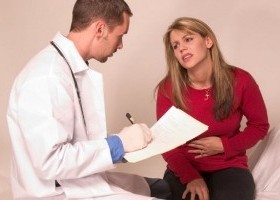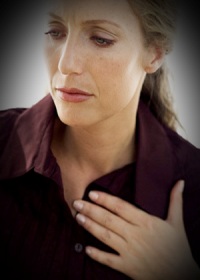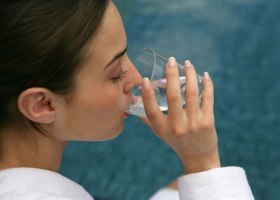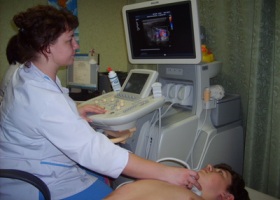August 16, 2012
- Gastal
- Constipation: Treatment and prevention
- Treatment of athlete's foot
- To lose weight, you need to have dinner no later than eight o'clock
If we compare the prevalence of diseases of the stomach and esophagus, the esophageal disease diagnosed now considerably less. If a person is healthy, the food passes through the esophagus, without stopping. Therefore, this body is less susceptible to a variety of stimuli.
Esophagus is a tube of cylindrical shape, the length of which is about 30 cm. The two places have fiziologicheskit narrowing of the esophagus esophagus narrows at the point where it intersects with aorta And in the location where it passes into the stomach. The wall of the esophagus mucosa, submucosa, muscular and adventitia. Let us consider in more detail some of the diseases of the esophagus.
Esophageal achalasia
Esophageal achalasia - It is a disorder of neurogenic nature, in which disrupts the function of the esophagus. In particular, the broken peristalsis and lower esophageal sphincter, which is the obturator mechanism between the stomach and esophagus, loses its ability to relax. The etiology of this disease is unknown, but now experts are talking about the presence of genetic, infectious and psychogenic location. Typically, the disease develops in people aged 20 to 40 years.
With the development of esophageal achalasia patient symptoms expressed frequent regurgitation ( regurgitation ). This food is thrown back into the mouth, it mixes with saliva and mucus. This usually happens if a person leans forward. In some cases, regurgitation leads to aspiration (going from entering the human lungs undigested food). In addition, patients periodically develop chest pain that may resemble seizures angina . At night, people can overcome bouts of coughing. Patients with esophageal achalasia, as a rule, are rapidly losing weight, until exhaustion.
The main method of diagnosis of this disease is an X-ray that allows you to assess the condition of the esophagus. In the early stages of the disease the person feels much better if you follow the gentle diet . Treatment of the disease is aimed at, to reduce the pressure in the region of the lower esophageal sphincter. Initially, using special machines, which contribute to his relaxation. It is widely used so-called method pnevmokardiodilatatsii under which a pneumatic sphincter relaxation. To reduce the pressure in the region of the sphincter, it is possible to use nitrates or calcium antagonists.
Spasm of the esophagus
 In some cases, food is hard to pass through the esophagus as a result of esophageal spasm . For this phenomenon is characterized by the development of smooth muscle contractions of the esophagus, which are spastic character. Typically, esophageal spasm occurs in people in a young age. More prone to the phenomenon of those who are easily exposed excitability of the nervous system characterized by instability. Spasm of the esophagus often develops as a result of stress , Total nervosa Too rapid absorption of food. In the latter case, the esophagus is irritated mechanically, and develops a spasm reflex.
In some cases, food is hard to pass through the esophagus as a result of esophageal spasm . For this phenomenon is characterized by the development of smooth muscle contractions of the esophagus, which are spastic character. Typically, esophageal spasm occurs in people in a young age. More prone to the phenomenon of those who are easily exposed excitability of the nervous system characterized by instability. Spasm of the esophagus often develops as a result of stress , Total nervosa Too rapid absorption of food. In the latter case, the esophagus is irritated mechanically, and develops a spasm reflex.
Inogla spasm may also occur at the location where the esophagus enters the stomach. In this case, we are talking about cardiospasm .
The main symptom of this disease is considered to be dysphagia . During the spasm of possible failure to undergo a complete food through the esophagus. At the same time, in some cases, the liquid food passes harder than hard. In addition, patients often have chest pain, regurgitation of food eaten, but such manifestations are not of a permanent nature. Esophageal spasm may last a few seconds or many hours. Sometimes it can also develop esophageal dilatation. If a patient develops cardiospasm, due to the dilation of the esophagus can occur just vomiting. Unlike gastric vomiting food appears immediately after the adoption of food, and in the vomit is present only food eaten without gastric juice. Most patients develop cramps as a result of the influence of some factors. Sometimes, with time they disappear completely.
During therapy stomach cramps should be strengthened nervous system . To do this, it is important that the patient complete rest, active exercise. Some medications are also used drugs - valerian . bromides . Because the spasms of the stomach occurs as a consequence of the excitation of the vagus nerve of the patient during the spasm be used to treat adrenaline . atropine . ephedrine . These tools are used inside or under the skin. It is also possible to combine atropine and papaverine .
Burns of the esophagus
The burn of the esophagus It develops if it get some chemicals. Typically, this occurs either accidentally or when attempting suicide. Medical statistics show that among the total number of people who received burns to the esophagus, about 70% of children who are not yet 10 years old. Such a large number of affected children is due to an oversight adults and young children the habit of "trying" all the taste.
In most people get burns esophagus after administration of sodium hydroxide, concentrated acid solutions, more rarely burns occur due to exposure to phenol, Lysol, an alcohol solution of iodine. If the irritant gets inside, it suffers not only the esophagus and the stomach, the mucosa of the mouth and throat. Depending on the concentration and quantity of a substance that has got inside, the degree of damage is determined. Accepted provide three degrees of burns the esophagus. With first-degree It occurs only defeat of the surface layers of the esophageal mucosa. With second degree also affected the muscle layer. To burn third degree Characteristic lesions all layers of the esophageal wall. When third-degree burns manifest not only local symptoms, but common symptoms: state shock and intoxication . If the patient suffered burns the esophagus second or third degree, he formed scarring in the esophagus.
The main symptom of this condition is a strong feeling of a burning sensation in the throat, mouth, chest. Often, a person drunk caustic liquid, immediately there is vomiting, may swell the lips.
If there is a heavy defeat, the victim may lose consciousness immediately, in a state of shock. Sometimes, for one or two days comes death. If death has not occurred, the patient may receive pronounced breathlessness as a consequence of laryngeal edema, vomiting with mucus and blood, increase in body temperature. A person can not swallow. If the wall of the esophagus is deeply shocked, it may be esophageal bleeding , Disrupting kidney function.
To establish a definitive diagnosis should undergo X-ray examination. However, in the first days after the defeat was not carried out, since it is important that the general condition of the patient has stabilized. While scarring tissue can also make oesophagoscopy, but it is very important to study carefully.
Patients with burns of the esophagus promptly hospitalized, and then parenterally administered funds for anesthesia. To display the contents of the stomach, the patient is administered gavage, oiled. Depending on the substance that caused the burn, chosen means of gastric lavage. If there is a case of doubt, made a gastric lavage milk. Note, however, that the effectiveness of gastric lavage is sharply reduced after six hours of poisoning. To ensure disintoxication therapy the patient is administered parenterally reopoligljukin . gemodez . saline . To avoid complications in the future state, apply antibiotics broad-spectrum parenterally. Also, to reduce the scar formations prescribers adrenal hormones . Individually doctor decides on the appointment of drugs that improve the functioning of the cardiovascular system, kidney function.
Foreign body in the esophagus
 In some cases, a person may diagnose the presence of foreign body in the esophagus . This occurs when the esophagus are large chunks neperezhevannoy food, or accidentally ingested objects are not intended for human consumption. In medical practice, the diagnosis of "foreign body in the esophagus" is set quite often. A similar phenomenon occurs in different situations: at too rapid absorption of food in laughter or conversation during the meal. Also in the esophagus often get bone chicken, fish, meat. Typically such a phenomenon, and for people who are often kept in the mouth inedible objects - paper clips, matches, etc. Mainly in the wall of the esophagus embedded foreign bodies, which have a pointed end. This may manifest inflammation esophageal wall. At its perforation can develop mediastinitis .
In some cases, a person may diagnose the presence of foreign body in the esophagus . This occurs when the esophagus are large chunks neperezhevannoy food, or accidentally ingested objects are not intended for human consumption. In medical practice, the diagnosis of "foreign body in the esophagus" is set quite often. A similar phenomenon occurs in different situations: at too rapid absorption of food in laughter or conversation during the meal. Also in the esophagus often get bone chicken, fish, meat. Typically such a phenomenon, and for people who are often kept in the mouth inedible objects - paper clips, matches, etc. Mainly in the wall of the esophagus embedded foreign bodies, which have a pointed end. This may manifest inflammation esophageal wall. At its perforation can develop mediastinitis .
The man, who was delayed in the esophagus large foreign body, feel the pain behind the breastbone, which is oppressive in nature. He has a feeling of having a foreign body in the esophagus, and the victim often can not even swallow liquids.
If a person is not just to provide medical assistance, a few days later in his general condition is much worse. Some foreign bodies can be detected by X-ray, but the smallest things does not always reveal.
Find and remove the foreign body can be through esophagoscopy. But at the same time, doctors take into account the point that some people often feel the presence of a foreign body in the esophagus wall when his injury.
If a patient complains of symptoms suggestive of swallowed foreign body, it needs as quickly as possible to carry out X-ray examination and oesophagoscopy (if needed). If you remove a foreign body on an outpatient basis is not possible, the person should be sent to the surgical hospital.
Experts recommend not to use traditional methods aimed at pushing foreign bodies. Such efforts can be completed even stronger its fixation in the esophagus.
An ulcer of the esophagus
The man esophageal ulcer develops due to insufficient cardia provoking leaking of gastric juices into the esophagus. It has a proteolytic activity. Very often ulcer occurs in combination with gastric ulcer and duodenal ulcer or with hiatal hernia. Generally, in the esophagus solitary ulcers appear, but sometimes develop and multiple ulcerations.
The manifestation of esophageal ulcers provoked by several factors. This pathology develops as a consequence of surgical interventions in the area of the gastroesophageal junction, hiatal hernia, in violation of gastric motility and others.
The main symptoms of ulcers of the esophagus is a constant heartburn , Appearance regurgitation, pain behind the breastbone, which become more intense in the process of eating and after. A typical symptom is intermittent regurgitation of acidic stomach contents.
To establish a diagnosis in the case of gastric ulcers can use esophagoscopy. Sometimes also conducted studies of feces to detect hidden bleeding.
To effectively treat stomach ulcers, was originally performed stage of preparation for therapy. For this it is important to clean the internal organs of parasites, if any have been detected.
This is followed by an intensive phase of recovery. During this period, important active and healthy lifestyle approach, adopting natural means to strengthen the body, regular, gentle diet . Alcohol and smoked food is strictly prohibited. If conservative treatment methods do not bring the proper result, surgery is indicated.
Erosion of the esophagus
 Erosion of the esophagus It manifested primarily bouts of heartburn. In the course of eating a person can observe the emergence of unpleasant feeling behind the breastbone. Very often these feelings are present, if he absorbs dry and hard food. Also in the morning the patient may occasionally nauseated. This condition occurs as a consequence of contact with gastric juices into the esophagus. As a result, irritate the esophagus, inflammation develops, and later - erosion.
Erosion of the esophagus It manifested primarily bouts of heartburn. In the course of eating a person can observe the emergence of unpleasant feeling behind the breastbone. Very often these feelings are present, if he absorbs dry and hard food. Also in the morning the patient may occasionally nauseated. This condition occurs as a consequence of contact with gastric juices into the esophagus. As a result, irritate the esophagus, inflammation develops, and later - erosion.
Erosion of the esophagus is found only in the process of gastropically survey. Erosion of the esophagus represent a danger to human health as their consequence may be the development of bleeding. If erosion occur very often, mucous deformed, and the scars may eventually break the patency of the esophagus.
Treatment of esophageal erosion, provides for the mandatory use of drugs that block the hydrochloric acid. It is necessary to adhere to a strict diet, giving up those products that stimulate the production of hydrochloric acid. This citrus fruit, alcohol, coffee, soda, spicy and fatty foods. It is important not to wash down the food with water.
In order to effectively neutralize the effect of hydrochloric acid, should always adhere to the fractional power and do not overeat. The food must be easy to digest, so you should choose cereals, pureed soups, steamed meat frayed. If the disease escalates, you must completely remove the menu, all fruits and vegetables that provoke aerogenesis . An effective means to reduce the level of gas production is a decoction of fennel or dill. Do not remove the heartburn, swallowing soda. In attacks of heartburn is best to drink a glass of water with honey or a little milk. If treatment is erosion of the esophagus does not bring the desired results, the patients underwent a biopsy .
Erosion of the esophagus - a disease that can cause very serious complications. Therefore, at the first symptoms, which cause suspicion on the development of erosion, it is important to visit a specialist.
Esophageal atresia
 Esophageal atresia It is a very serious defect, which is characterized by a blind end of the upper segment of the esophagus. The lower section of the esophagus generally communicates with the trachea. Very often there are esophageal atresia and other congenital malformations of various body systems.
Esophageal atresia It is a very serious defect, which is characterized by a blind end of the upper segment of the esophagus. The lower section of the esophagus generally communicates with the trachea. Very often there are esophageal atresia and other congenital malformations of various body systems.
The reason for existence of this pathology are considered significant violations during fetal development. If a 4-5 week embryo development it affect certain hazards, the consequence can be formed after the esophagus wrong.
Atresia of the esophagus in a sick child immediately after birth manifested coughing, cyanosis. The child accumulates in the throat mucus from the mouth and nose appear frothy. During feeding all these symptoms are aggravated. The child is worried, he has a shortness of breath, wheezing in the lungs. Later develops respiratory insufficiency and pneumonia Which reason becomes Inhalation milk and stomach contents.
To establish a diagnosis, the child is held esophageal intubation. The diagnosis is usually set still in the maternity ward. If necessary, the x-ray.
Esophageal atresia can be cured by surgery alone. Prepare the child for surgery is still in the nursing home. A method of performing operations is selected depending on the nature of the pathology. It is important to take into account that the operation should be carried out as soon as possible.
Esophageal candidiasis
Candidiasis - A disease of an infectious nature, which affects the mucous membranes. But esophageal candidiasis considered visceral disease. The most common esophageal candidiasis develops as a consequence of burning the esophagus, as well as in certain chronic diseases of the body. When a person feels esophageal candidiasis pain when swallowing , So that it is hard enough to do it. During swallowing, chest discomfort is felt. Most often diagnosed esophageal candidiasis in people with impairments in functioning immune system antibiotics . .
.

With
.
No comments:
Post a Comment